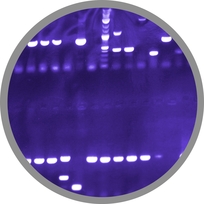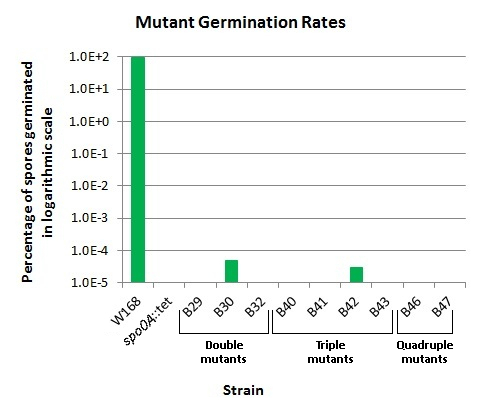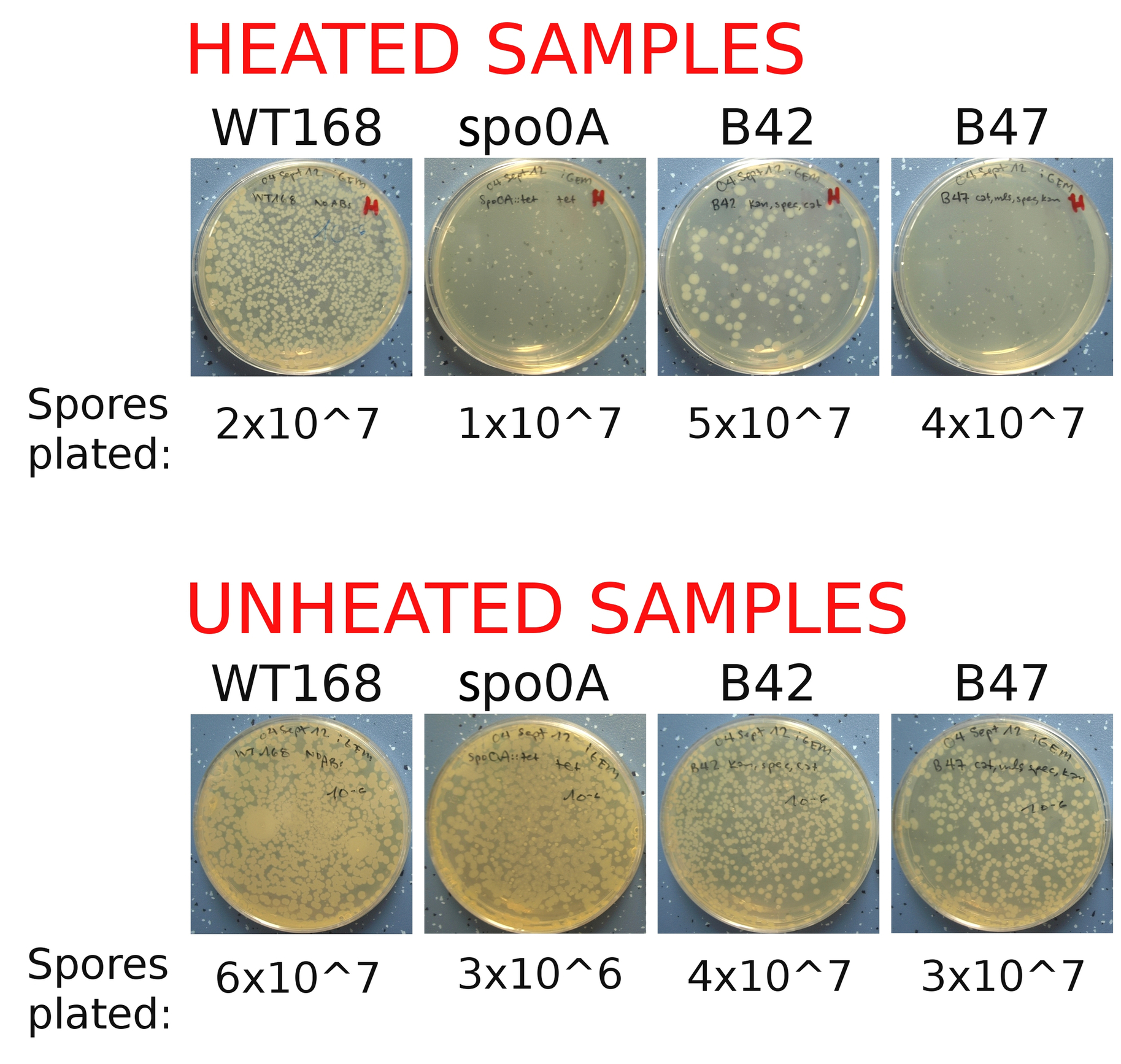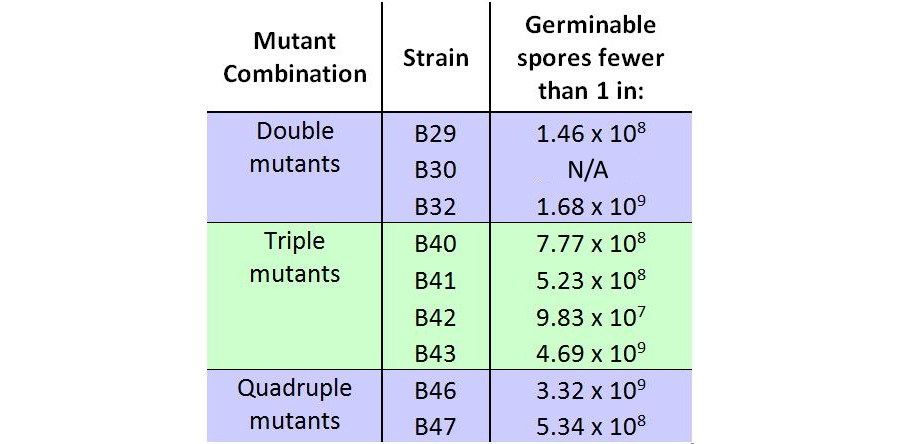Team:LMU-Munich/Data/Knockout
From 2012.igem.org
| Line 7: | Line 7: | ||
===Knockouts of germination genes === | ===Knockouts of germination genes === | ||
| - | <p align="justify">We incubated our mutant strains in Difco sporulation media (DSM) at 37°C, shaking at 230RPM for 18-24 hours to induce sporulation. We heated 1 milliliter of each of the DSM cultures at 80°C for one hour to kill | + | <p align="justify">We incubated our mutant strains in Difco sporulation media (DSM) at 37°C, shaking at 230RPM for 18-24 hours to induce sporulation. We heated 1 milliliter of each of the DSM cultures at 80°C for one hour to kill vegetative cells, and used 1 milliliter at room temperature (allowing living cells to survive). From here, we quantified the cells and spores per milliliter of each culture using a Neubauer cell counting chamber. Then on LB-agar, we plated different dilutions of the cultures, with heated and unheated cultures on separate plates. Plates were kept at 37°C for minimally 24 hours. We then quantified the colonies on each plate, and used this to check for cell growth and calculate the spore germination rate for each mutant strain. For details on this germination assay, see [https://2012.igem.org/Team:LMU-Munich/Lab_Notebook/Protocols Protocols]. The germination assays were carried out several times, and yielded similar results each time. The results are shown in the graph below.</p> |
<br> | <br> | ||
| Line 35: | Line 35: | ||
<br> | <br> | ||
| - | <p align="justify">The | + | <p align="justify">The next figure showing the LB-agar plates from the germination assays (see below) demonstrates the inability of our mutant spores to germinate. We can say that fewer than 1 out of 3x10<sup>7</sup> spores of strains B40, B41, B43, B46, and B47 germinated. |
The plates below demonstrate the procedure of plating for the germination assay. Plates here include those containing heated and unheated cultures, and show both germinable spores (B42) and spores unable to germinate (B47). These plating experiments allowed us to quantify the number of ingerminable spores in each culture. | The plates below demonstrate the procedure of plating for the germination assay. Plates here include those containing heated and unheated cultures, and show both germinable spores (B42) and spores unable to germinate (B47). These plating experiments allowed us to quantify the number of ingerminable spores in each culture. | ||
<br> | <br> | ||
| Line 51: | Line 51: | ||
{| style="color:black;" cellpadding="3" width="95%" cellspacing="0" border="0" align="left" style="text-align:left;" | {| style="color:black;" cellpadding="3" width="95%" cellspacing="0" border="0" align="left" style="text-align:left;" | ||
|style="width: 70%;background-color: #EBFCE4;" | | |style="width: 70%;background-color: #EBFCE4;" | | ||
| - | <font color="#000000"; size="2">'''Plates of germination mutants.''' Plates contained heated (to kill | + | <font color="#000000"; size="2">'''Plates of germination mutants.''' Plates contained heated (to kill vegetative cells and leave only spores to germinate) cultures and unheated (where colonies may come from germinated spores and the vegetative cells) cultures. The mutant ''spo0A''::tet is unable to form spores, and should therefore show no germination (our negative control). The mistake of photographing empty plates against a background of spots was realized after plates had been discarded. Presence of colonies is noted below, for clarity. Mutants used were: <br /> |
'''WT168''': Wild-type 168; <span style="color:red">Heated plate: colonies present</span>; Unheated plate: colonies present <br /> | '''WT168''': Wild-type 168; <span style="color:red">Heated plate: colonies present</span>; Unheated plate: colonies present <br /> | ||
'''''spo0A''::tet''': A sporulation-deficient strain; <span style="color:red">Heated plate: no colonies</span>; Unheated plate: colonies present <br /> | '''''spo0A''::tet''': A sporulation-deficient strain; <span style="color:red">Heated plate: no colonies</span>; Unheated plate: colonies present <br /> | ||
Revision as of 19:31, 26 September 2012

The LMU-Munich team is exuberantly happy about the great success at the World Championship Jamboree in Boston. Our project Beadzillus finished 4th and won the prize for the "Best Wiki" (with Slovenia) and "Best New Application Project".
[ more news ]

Knockouts of germination genes
We incubated our mutant strains in Difco sporulation media (DSM) at 37°C, shaking at 230RPM for 18-24 hours to induce sporulation. We heated 1 milliliter of each of the DSM cultures at 80°C for one hour to kill vegetative cells, and used 1 milliliter at room temperature (allowing living cells to survive). From here, we quantified the cells and spores per milliliter of each culture using a Neubauer cell counting chamber. Then on LB-agar, we plated different dilutions of the cultures, with heated and unheated cultures on separate plates. Plates were kept at 37°C for minimally 24 hours. We then quantified the colonies on each plate, and used this to check for cell growth and calculate the spore germination rate for each mutant strain. For details on this germination assay, see Protocols. The germination assays were carried out several times, and yielded similar results each time. The results are shown in the graph below.
|
The next figure showing the LB-agar plates from the germination assays (see below) demonstrates the inability of our mutant spores to germinate. We can say that fewer than 1 out of 3x107 spores of strains B40, B41, B43, B46, and B47 germinated.
The plates below demonstrate the procedure of plating for the germination assay. Plates here include those containing heated and unheated cultures, and show both germinable spores (B42) and spores unable to germinate (B47). These plating experiments allowed us to quantify the number of ingerminable spores in each culture.
The purpose of plating both heated and unheated cultures was to demonstrate the viability of the unheated cells in each culture. This makes evident that the lack of colonies on heated plates is not due to the inability of the strain to grow, but from the inability of spores to germinate into vegetative cells capable of growing. For all germination mutants, vegetative cells were able to grow and form colonies.
|
The table below shows the maximum number of spores from heated cultures plated which yielded zero colonies. In the case of B30, the germination assay was performed only once, and as visible in the above graph "Mutant Germination Rates," contained viable, germinable spores. The numbers shown here are the highest number of spores plated, excluding B30. This means that we do not have data for higher concentrations of spores which would suggest any spore germinability. The mutant strain B42 contained germinable spores when 4x10^7 were plated, but contrarily, zero germinable spores were found when 9.83x10^7 spores were plated in another round of the germination assay.
|
 "
"







